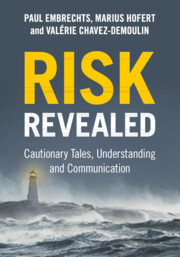Book contents
- Frontmatter
- Dedication
- Contents
- Preface
- Introduction
- 1 The 1953 Great Flood
- 2 The Space Shuttle Challenger Disaster
- 3 The 2007–2008 Financial Crisis
- 4 Earthquakes and Tsunamis
- 5 The L’Aquila Trial and the Public Communication of Risk
- 6 The Coronavirus Pandemic
- 7 Mathematical Wonderland
- 8 Stochastic Modeling
- 9 The Modeling of Extreme Events
- 10 On Climate Change and Related Risk
- 11 Further Examples from the World of Extremes
- 12 Networks
- 13 The Black Tulip and February 3, 1637
- A Note About the References
- References
- Index
3 - The 2007–2008 Financial Crisis
Published online by Cambridge University Press: 05 April 2024
- Frontmatter
- Dedication
- Contents
- Preface
- Introduction
- 1 The 1953 Great Flood
- 2 The Space Shuttle Challenger Disaster
- 3 The 2007–2008 Financial Crisis
- 4 Earthquakes and Tsunamis
- 5 The L’Aquila Trial and the Public Communication of Risk
- 6 The Coronavirus Pandemic
- 7 Mathematical Wonderland
- 8 Stochastic Modeling
- 9 The Modeling of Extreme Events
- 10 On Climate Change and Related Risk
- 11 Further Examples from the World of Extremes
- 12 Networks
- 13 The Black Tulip and February 3, 1637
- A Note About the References
- References
- Index
Summary
The 2007 – 2008 financial crisis has been the subject of many articles, books, movies and even a theater play. We take you for a walk along Wall Street, pointing at some aspects of the story that touch our personal experiences and interests. We look critically at some of the main underlying causes. Besides political blindness, we highlight the unbridled growth of power of relatively small groups of investment bankers and how these brought financial institutions to (and in some cases beyond) the edge of bankruptcy. We expose some of the over-complicated financial instruments together with their astronomical volumes traded. We also look more critically at the role played by quants (financial engineers) in general and mathematicians in particular. What is the truth behind “The formula that killed Wall Street”? An important aspect concerns early warnings not heeded to. In summary, this is a chapter on greed, power, complexity, volume and stupidity.
Keywords
- Type
- Chapter
- Information
- Risk RevealedCautionary Tales, Understanding and Communication, pp. 24 - 42Publisher: Cambridge University PressPrint publication year: 2024



